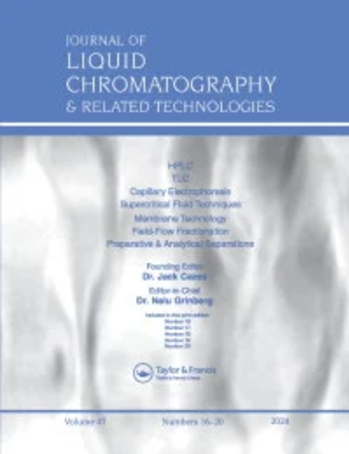基于多技术的肺癌芪山方q标记物及其潜在机制研究
IF 1
4区 化学
Q4 BIOCHEMICAL RESEARCH METHODS
Journal of Liquid Chromatography & Related Technologies
Pub Date : 2023-05-31
DOI:10.1080/10826076.2023.2216765
引用次数: 0
摘要
摘要岐山方主要用于治疗癌症及其放化疗副作用。尽管QSF的临床疗效已得到认可,但其作用机制和有效成分尚不清楚。本研究旨在探索QSF潜在的Q标记物,揭示其抗癌症的机制。首先建立了10批QSF的指纹图谱,通过化学计术筛选潜在的Q标志物,然后运用网络药理学和分子对接方法探讨其抗癌症的机制。最后,通过UPLC-QDA对潜在的Q标记物进行了定量分析。结果表明,所建立的指纹图谱共鉴定出48个共有峰,并通过化学计学筛选出calycosin、人参皂苷Rg1、苍术内酯III、苍术皂苷I和人参皂苷Rb1作为QSF的潜在Q标记。网络药理学和分子对接发现,潜在的Q标记物可以通过FOS、IL6、EGFR、ESR1、MAPK1和MAPK3等靶点调节各种信号通路,并在癌症中发挥治疗作用。此外,建立的UPLC-QDA还可以对QSF的Q标记进行质量控制。本研究可为QSF等复方制剂的综合质量控制和机理研究提供学术思路,奠定基础。图形摘要本文章由计算机程序翻译,如有差异,请以英文原文为准。
Uncovering the Q-marker and potential mechanisms of Qishan Formula for lung cancer based on multi-technology
Abstract Qishan Formula (QSF) is mainly used to treat lung cancer and its side effects of radiotherapy and chemotherapy. Although the clinical efficacy of QSF has been recognized, its mechanism of action and active ingredients are still unclear. This study aims to explore the potential Q-Marker of QSF and reveal its anti-lung cancer mechanism. Firstly, the fingerprints of 10 batches of QSF were established, and the potential Q-markers were screened by chemometrics, then network pharmacology and molecular docking methods were used to explore its anti-lung cancer mechanism. Finally, the potential Q-markers were quantitatively by UPLC-QDA. The results showed that 48 common peaks were identified by the established fingerprint, and calycosin, ginsenoside Rg1, atractylenolide III, atractylenolide I and ginsenoside Rb1 were screened as potential Q-Markers of QSF by chemometrics. Network pharmacology and molecular docking found that the potential Q-Markers may regulate various signaling pathways through targets such as FOS, IL6, EGFR, ESR1, MAPK1, and MAPK3, and play a therapeutic role in lung cancer. Besides, the established UPLC-QDA can also perform quality control for Q-Markers of QSF. This study can provide academic ideas and lay a foundation for the comprehensive quality control and mechanism research of QSF and other compound preparation. Graphical Abstract
求助全文
通过发布文献求助,成功后即可免费获取论文全文。
去求助
来源期刊
CiteScore
2.80
自引率
0.00%
发文量
29
审稿时长
4.9 months
期刊介绍:
The Journal of Liquid Chromatography & Related Technologies is an internationally acclaimed forum for fast publication of critical, peer reviewed manuscripts dealing with analytical, preparative and process scale liquid chromatography and all of its related technologies, including TLC, capillary electrophoresis, capillary electrochromatography, supercritical fluid chromatography and extraction, field-flow technologies, affinity, and much more. New separation methodologies are added when they are developed. Papers dealing with research and development results, as well as critical reviews of important technologies, are published in the Journal.

 求助内容:
求助内容: 应助结果提醒方式:
应助结果提醒方式:


